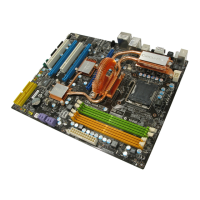
Do you have a question about the MSI MS-7380 and is the answer not in the manual?
| Model | MS-7380 |
|---|---|
| Form Factor | ATX |
| Memory Type | DDR2 |
| Maximum Memory | 4 GB |
| Memory Slots | 2 |
| Expansion Slots | 1 x PCIe x16, 2 x PCIe x1, 3 x PCI |
| Storage Interfaces | 4 x SATA 3Gb/s, 1 x IDE |
| USB Ports | 8 (4 on back panel, 4 via headers) |
| Audio | Realtek ALC888 |
| LAN | Realtek RTL8111B Gigabit LAN |
| Chipset | Intel G31 |
Lists essential guidelines for safe equipment operation and handling.
Caution regarding battery replacement, specifying replacement with the same type.
Details the technical specifications of the P7N SLI Platinum Series mainboard.
Visual guide illustrating the physical layout of the mainboard components and connectors.
Lists all items included in the product package for user verification.
An overview of the main components and their locations on the mainboard.
Step-by-step instructions for installing the Central Processing Unit (CPU) and cooler.
Guidance on installing memory modules, including dual-channel rules.
Details the ATX 24-pin and 8-pin power connectors and their pin definitions.
Explains the function of each port located on the mainboard's back panel.
Describes various internal connectors like IDE, SATA, FDD, and headers.
Information on the available PCI Express and PCI slots for expansion cards.
Instructions on how to enter the BIOS setup and use control keys for navigation.
Overview of the main categories and functions available in the BIOS setup utility.
Configuration settings for system date, time, and IDE/SATA device parameters.
Settings for advanced system features like booting, CPU features, and chipset configurations.
Configuration options for onboard devices such as USB, LAN, and Audio controllers.
Settings related to ACPI functions and system power saving modes.
Displays system hardware status including temperatures, voltages, and fan speeds.
Options for CPU/FSB/DRAM frequency adjustment and dynamic overclocking.
Options to save/load custom settings or load system defaults for stability/performance.
Restores BIOS settings to fail-safe or optimized default values.
Functionality to set a password for accessing the BIOS setup.
Procedure for installing the Realtek HD Audio driver for full functionality.
Covers software setup, sound effects, mixer, audio I/O, microphone, and 3D audio settings.
Overview of NVIDIA RAID technology and supported operating systems.
Steps for configuring RAID arrays using BIOS and Windows utilities.
Instructions for installing NVIDIA RAID drivers for bootable and non-bootable arrays.
Covers viewing configurations, managing spare disks, initializing, rebuilding, and synchronizing arrays.
Explains JMicron RAID levels (0, 1, 10) and JBOD functionality.
Steps to configure RAID arrays using the JMicron BIOS utility.
Procedures for installing JMicron RAID drivers in Windows.
Using the JMicron Raid Configurer tool for managing RAID arrays.
Introduces Dual Core Center utility and its system requirements for installation.
Guide on how to activate and launch the Dual Core Center utility.
Explains the main interface and various settings like clock, voltage, fan speed, and user profiles.